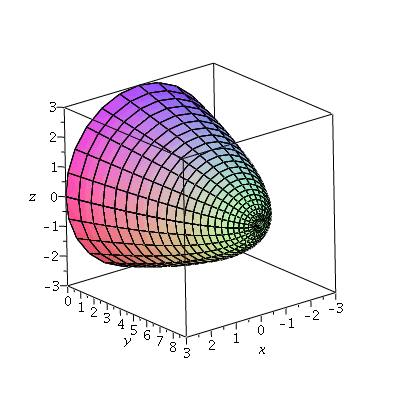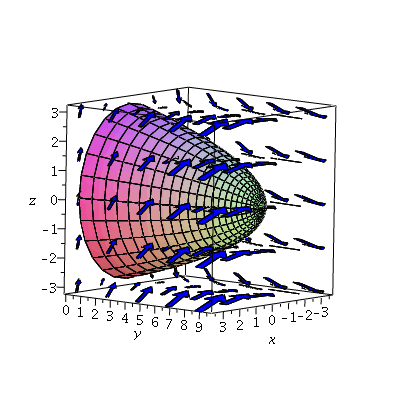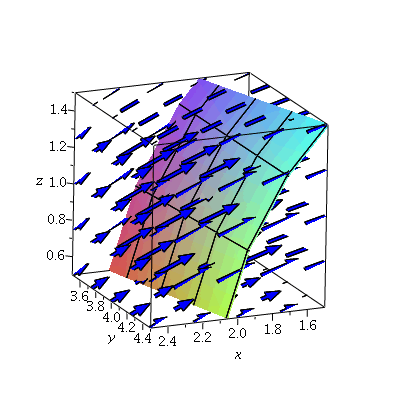
| > | with(plots): |
A nice surface:
| > | sp:=plot3d([r*cos(t),9-r^2,r*sin(t)],r=0..3,t=0..2*Pi,axes=boxed,labels=[x,y,z]):
sp; |
 |
And a nice vector field:
| > | vp:=fieldplot3d([-y,1,x],x=-3..3,y=0..9,z=-3..3,axes=boxed,labels=[x,y,z],arrows=THICK,color=blue,grid=[5,5,5]):
vp; |
 |
And the two together
| > | display3d(sp,vp); |
 |
Let's zoom in to see what's going on at a specific point, say (2,4,1)
| > | zs:=plot3d([r*cos(t),9-r^2,r*sin(t)],r=1.75..3.25,t=0...5,axes=boxed,labels=[x,y,z],view=[1.5..2.5,3.5..4.5,0.5..1.5]):
zp:=display3d(zs,fieldplot3d([-y,1,x],x=1.5..2.5,y=3.5..4.5,z=0.5..1.5,axes=boxed,labels=[x,y,z],arrows=THICK,color=blue,grid=[5,5,5],view=[1.5..2.5,3.5..4.5,0.5..1.5])): zp; |
 |
Exactly at the point (2,4,1), the vector field points in the direction
![]()
and a normal to the surface is
![]()
The unit normal is
![]()
That is:
| > |
fvec := arrow({[[2,4,1],[-4,1,2]]},length=[.5,relative=false],color=blue): nvec := arrow({[[2,4.098,.95],[-4,-1,-2]]},length=[.5,relative=false],color=red): fvnorm := arrow({[[2,4,1],[-4,-1,-2]]},length=[11/(2*(21)),relative=false],width=[.025,relative=false],color="Purple"): display3d(zs,fvec,nvec,fvnorm); |
 |
The purple vector is the component of F that is pointing through (normal to) the surface. The red vector is the normal to the surface, moved to the side a little so that it doesn't overwrite the purple vector.
Then, when we integrate ![]() over the surface, we're adding up the length of the component of F in the direction through the surface times the area: thus, if F is a velocity field (measured in m/s), we get a flux of
over the surface, we're adding up the length of the component of F in the direction through the surface times the area: thus, if F is a velocity field (measured in m/s), we get a flux of ![]() /s: a volume flow-rate through the surface.
/s: a volume flow-rate through the surface.
| > |